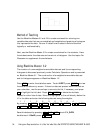
Introducing the Topic
In this chapter, you and your students will learn how to use the Sharp
graphing calculator to represent a one-variable data set with a broken-line
graph (frequency polygon) and a box-and-whisker chart.
Typically, a broken-line graph is represented on a horizontal (x) axis scaled
according to the data, with a vertical (y) axis scaled according to the data's
frequency individually (discrete) or within an interval (continuous). In each case, a
point is plotted at the coordinates (x, frequency) for a discrete distribution or the
coordinates (interval right-point, interval frequency). Lines are then drawn from one
of these points to the next one. Remember, when using intervals, you should seek
between 5 and 7 intervals. Once again, there will be times you will need more or less
intervals. Interval widths can be determined logically or mathematically. Remember,
the object of viewing a broken-line graph is to obtain or portray characteristics of the
data's distribution. Therefore, the number of intervals may vary.
A box-and-whisker chart is a graph that consists of five points of interest. The
25th percentile, 50th percentile, and 75th percentiles are each indicated with a
vertical line. The three vertical lines are then connected together in order to
form a box. Next, vertical lines are extended away from the box to the minimum
and maximum. These are called the whiskers of the chart.
16 Other Graphical Portrayals of a One-Variable Data Set/STATISTICS USING THE SHARP EL-9600
OTHER GRAPHICAL PORTRAYALS
OF A ONE-VARIABLE DATA SET
Chapter four


















